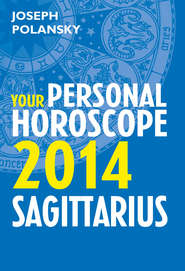скачать книгу бесплатно
Lunar
Relating to the Moon. See also ‘Phases of the Moon’, below.
Natal
Literally means ‘birth’. In astrology this term is used to distinguish between planetary positions that occurred at the time of a person’s birth (natal) and those that are current (transiting). For example, Natal Sun refers to where the Sun was when you were born; transiting Sun refers to where the Sun’s position is currently at any given moment – which usually doesn’t coincide with your birth, or Natal, Sun.
Out of Bounds
The planets move through the zodiac at various angles relative to the celestial equator (if you were to draw an imaginary extension of the Earth’s equator out into the universe, you would have an illustration of this celestial equator). The Sun – being the most dominant and powerful influence in the Solar system – is the measure astrologers use as a standard. The Sun never goes more than approximately 23 degrees north or south of the celestial equator. At the winter solstice the Sun reaches its maximum southern angle of orbit (declination); at the summer solstice it reaches its maximum northern angle. Any time a planet exceeds this Solar boundary – and occasionally planets do – it is said to be ‘out of bounds’. This means that the planet exceeds or trespasses into strange territory – beyond the limits allowed by the Sun, the Ruler of the Solar system. The planet in this condition becomes more emphasized and exceeds its authority, becoming an important influence in the forecast.
Phases of the Moon
After the full Moon, the Moon seems to shrink in size (as perceived from the Earth), gradually growing smaller until it is virtually invisible to the naked eye – at the time of the next new Moon. This is called the waning Moon phase, or the waning Moon.
After the new Moon, the Moon gradually gets bigger in size (as perceived from the Earth) until it reaches its maximum size at the time of the full Moon. This period is called the waxing Moon phase, or waxing Moon.
Retrogrades
The planets move around the Sun at different speeds. Mercury and Venus move much faster than the Earth, while Mars, Jupiter, Saturn, Uranus, Neptune and Pluto move more slowly. Thus there are times when, relative to the Earth, the planets appear to be going backwards. In reality they are always going forward, but relative to our vantage point on Earth they seem to go backwards through the zodiac for a period of time. This is called ‘retrograde’ motion and tends to weaken the normal influence of a given planet.
Short-term Planets
The fast-moving planets move so quickly through a sign that their effects are generally of a short-term nature. They reflect the immediate, day-to-day trends in a horoscope.
Moon
stays in a sign for only 2½ days
Mercury
20 to 30 days
Sun
30 days
Venus
approximately 1 month
Mars
approximately 2 months
T-square
A T-square differs from a Grand Square (#uae544944-5e46-478f-a6b1-f6414a63e347) in that it is not a complete square. If you look at the pattern in a chart it appears as ‘half a complete square’, resembling the T-square tools used by architects and designers. If you cut a complete square in half, diagonally, you have a T-square. Many astrologers consider this more stressful than a Grand Square, as it creates tension that is difficult to resolve. T-squares bring learning experiences.
Transits
This term refers to the movements or motions of the planets at any given time. Astrologers use the word ‘transit’ to make the distinction between a birth, or Natal, planet (see ‘Natal (#uf12d6d08-8efd-4da3-9fd3-03550674fedc)’) and the planet’s current movement in the heavens. For example, if at your birth Saturn was in the sign of Cancer in your 8th house, but is now moving through your 3rd house, it is said to be ‘transiting’ your 3rd house. Transits are one of the main tools with which astrologers forecast trends.
(#ub4ea5020-0c63-516e-bee3-31f62e220ca5)
Personality Profile
SAGITTARIUS AT A GLANCE
Element – Fire
Ruling Planet – Jupiter
Career Planet – Mercury
Love Planet – Mercury
Money Planet – Saturn
Planet of Health and Work – Venus
Planet of Home and Family Life – Neptune
Planet of Spirituality – Pluto
Colours – blue, dark blue
Colours that promote love, romance and social harmony – yellow, yellow-orange
Colours that promote earning power – black, indigo
Gems – carbuncle, turquoise
Metal – tin
Scents – carnation, jasmine, myrrh
Quality – mutable (= flexibility)
Qualities most needed for balance – attention to detail, administrative and organizational skills
Strongest virtues – generosity, honesty, broad-mindedness, tremendous vision
Deepest need – to expand mentally
Characteristics to avoid – over-optimism, exaggeration, being too generous with other people’s money
Signs of greatest overall compatibility – Aries, Leo
Signs of greatest overall incompatibility – Gemini, Virgo, Pisces
Sign most helpful to career – Virgo
Sign most helpful for emotional support – Pisces
Sign most helpful financially – Capricorn
Sign best for marriage and/or partnerships – Gemini
Sign most helpful for creative projects – Aries
Best Sign to have fun with – Aries
Signs most helpful in spiritual matters – Leo, Scorpio
Best day of the week – Thursday
Understanding a Sagittarius
If you look at the symbol of the archer you will gain a good, intuitive understanding of a person born under this astrological sign. The development of archery was humanity’s first refinement of the power to hunt and wage war. The ability to shoot an arrow far beyond the ordinary range of a spear extended humanity’s horizons, wealth, personal will and power.
Вы ознакомились с фрагментом книги.
Для бесплатного чтения открыта только часть текста.
Приобретайте полный текст книги у нашего партнера:
